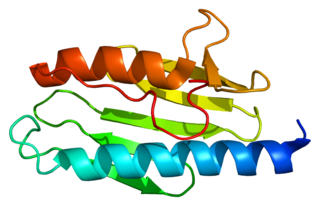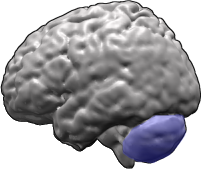Ataxia is a neurological sign consisting of lack of voluntary coordination of muscle movements that can include gait abnormality, speech changes, and abnormalities in eye movements. Ataxia is a clinical manifestation indicating dysfunction of the parts of the nervous system that coordinate movement, such as the cerebellum. Ataxia can be limited to one side of the body, which is referred to as hemiataxia. Several possible causes exist for these patterns of neurological dysfunction. Dystaxia is a mild degree of ataxia. Friedreich's ataxia has gait abnormality as the most commonly presented symptom. The word is from Greek α- [a negative prefix] + -τάξις [order] = "lack of order".
Ataxia–telangiectasia, also referred to as ataxia–telangiectasia syndrome or Louis–Bar syndrome, is a rare, neurodegenerative, autosomal recessive disease causing severe disability. Ataxia refers to poor coordination and telangiectasia to small dilated blood vessels, both of which are hallmarks of the disease.

Friedreich's ataxia is an autosomal-recessive genetic disease that causes difficulty walking, a loss of sensation in the arms and legs, and impaired speech that worsens over time. Symptoms generally start between 5 and 20 years of age. Many develop hypertrophic cardiomyopathy and require a mobility aid such as a cane, walker, or wheelchair in their teens. As the disease progresses, people lose their sight and hearing. Other complications include scoliosis and diabetes mellitus.

Spinocerebellar ataxia (SCA) is a progressive, degenerative, genetic disease with multiple types, each of which could be considered a neurological condition in its own right. An estimated 150,000 people in the United States have a diagnosis of spinocerebellar ataxia at any given time. SCA is hereditary, progressive, degenerative, and often fatal. There is no known effective treatment or cure. SCA can affect anyone of any age. The disease is caused by either a recessive or dominant gene. In many cases people are not aware that they carry a relevant gene until they have children who begin to show signs of having the disorder.
Sensory ataxia is both a symptom and a sign in neurology. It is a form of ataxia caused not by cerebellar dysfunction but by loss of sensory input into the control of movement.
Cerebellar ataxia is a form of ataxia originating in the cerebellum. Non-progressive congenital ataxia (NPCA) is a classical presentation of cerebral ataxias.

Nandopsis is a small genus of cichlid fishes found in lakes, streams and rivers in Cuba and Hispaniola. Nandopsis are the only cichlids native to the Antilles.
Episodic ataxia (EA) is an autosomal dominant disorder characterized by sporadic bouts of ataxia with or without myokymia. There are seven types recognized but the majority are due to two recognized entities. Ataxia can be provoked by psychological stress or startle, or heavy exertion, including exercise. Symptoms can first appear in infancy. There are at least six loci for EA, of which 4 are known genes. Some patients with EA also have migraine or progressive cerebellar degenerative disorders, symptomatic of either familial hemiplegic migraine or spinocerebellar ataxia. Some patients respond to acetazolamide though others do not.

Ataxia, described by Haldeman in 1847, is an American genus of longhorn beetles of the subfamily Lamiinae, tribe Pteropliini.
Pimenta haitiensis is a species of plant in the family Myrtaceae. It is endemic to the Dominican Republic.

Cav2.1, also called the P/Q voltage-dependent calcium channel, is a calcium channel found mainly in the brain. Specifically, it is found on the presynaptic terminals of neurons in the brain and cerebellum. Cav2.1 plays an important role in controlling the release of neurotransmitters between neurons. It is composed of multiple subunits, including alpha-1, beta, alpha-2/delta, and gamma subunits. The alpha-1 subunit is the pore-forming subunit, meaning that the calcium ions flow through it. Different kinds of calcium channels have different isoforms (versions) of the alpha-1 subunit. Cav2.1 has the alpha-1A subunit, which is encoded by the CACNA1A gene. Mutations in CACNA1A have been associated with various neurologic disorders, including familial hemiplegic migraine, episodic ataxia type 2, and spinocerebellar ataxia type 6.

Potassium voltage-gated channel, Shaw-related subfamily, member 3 also known as KCNC3 or Kv3.3 is a protein that in humans is encoded by the KCNC3.

Ataxia is the sixth studio album released by alternative / psychedelic-rock band Circus Devils on October 31, 2008. All songs on Ataxia were written and performed by Robert Pollard, Todd Tobias, and Tim Tobias.
Gobioclinus haitiensis, the longfin blenny, is a species of labrisomid blenny native to the western Atlantic Ocean including the Gulf of Mexico and the Caribbean Sea. This species inhabits such habitats as reefs, beds of seagrass and near shore rocky or rubble substrates with plentiful algal growth. This species can reach a length of 7.5 centimetres (3.0 in) TL. It can also be found in the aquarium trade.

Acetergamine is an organic chemical compound; specifically it is a derivative of ergoline, making it a member of the ergotamine family of compounds. Acetergamine currently has no mainstream uses, however its potential as an alpha-1 blocker and vasodilator has led to it being covered in several patents concerning therapies for erectile dysfunction. It has also been investigated as a treatment for cerebellar ataxia.
Eupogonius haitiensis is a species of beetle in the family Cerambycidae. It was described by Fisher in 1935. It is known from Hispaniola.
Peripatus haitiensis is a species of velvet worm in the Peripatidae family. The type locality is in Haiti.

Truncal ataxia is a wide-based "drunken sailor" gait characterised by uncertain starts and stops, lateral deviations and unequal steps. It is an instability of the trunk and often seen during sitting. It is most visible when shifting position or walking heel-to-toe.
Annona haitiensis is a species of plant in the Annonaceae family. It is native to the Dominican Republic and Haiti. Robert Elias Fries, the Swedish botanist who first formally described the species, named it after Haiti where the specimen he examined was collected.
Casasia haitensis is a species of plant that is native to Haiti. It belongs to the family Rubiaceae.






